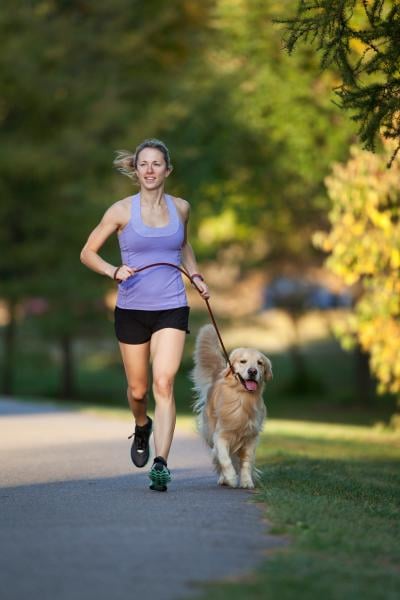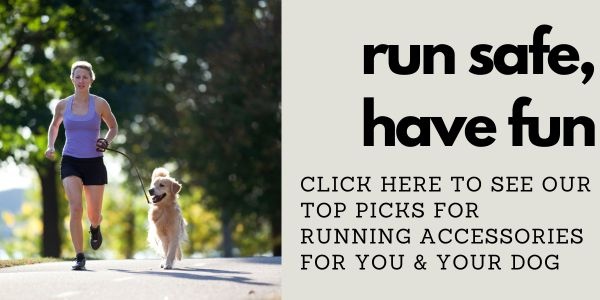 Having a companion to exercise with is perhaps one of the best motivations to get up, get out, and get going. And that includes having a dog to run with! But hold up before you strap on your newest set of running shoes and snap on their leash for your very first run together.
Having a companion to exercise with is perhaps one of the best motivations to get up, get out, and get going. And that includes having a dog to run with! But hold up before you strap on your newest set of running shoes and snap on their leash for your very first run together.
There are some things to think about before you hit the streets or the trails with your dog to ensure you both stay safe and enjoy running together for a long time to come.
Running has some great cardiovascular health, training, and behavioral benefits for dogs. Just like we’re not going to get up off the couch and run a half-marathon, your dog isn't going to be ready to start running so easily, either. There are a number of things you both have to think of first to ensure you don’t injure yourself or them or end up at the emergency room or urgent care.
Table of Contents
Before Your Run
The first thing you want to do before running with your dog is make sure they should be running with you and if they're ready. Learn more about how to tell whether your dog is ready to go running with you here.
Are Weather Conditions Okay for a Run with Your Dog?
Just like we need to consider the weather conditions prior to heading out on a run, we need to do the same for our dogs.
Running with Your Dog When It's Hot Out
Running in 85-degree weather doesn’t sound pleasant for us — imagine doing it wearing a fur coat that you can’t take off. Check with your veterinarian about your dog’s individual heat stroke risk and get specific recommendations of what temperatures are safe for your dog to exercise in.
Not only do dogs overheat more easily than humans do, but they also don’t cool down through sweating the way we do. Instead, they sweat through their paws and cool down through panting! A situation that is not ideal when running let alone in the heat.
Be careful when it's warm out, and avoid running in the midday heat. Ideally, run with your dog in shadier areas and, when possible, avoid asphalt, blacktop, and sand, all of which can burn your pup's paws.
Go in the cooler hours of the morning or evenings or on shady trails or consider only running with the pup in the cooler months and let them enjoy some time off during the summer!
When it's hot and sunny, asphalt temperatures are much higher than outside temperatures and can burn your dog’s paw pads. If you put the back of your hand against the hot surface for five to seven seconds — if it's too hot for you, then it's too hot for your dog's paws.
Running with Your Dog When It's Cold Out
Conversely, cold weather also poses particular risks when taking your pup out for a run. Frostbite can occur on their paws, ears, and snout or nose if not appropriately protected. If you do choose to run in winter with your pup, try to avoid running on roads or streets treated with salt or ice melt that can damage their paws.
When running in extreme temperatures, we recommend fitting your dog with booties to protect their paws in both hot and cold weather. Make sure they fit properly and are designed for running (see examples below), and to acclimate your dog to them before use.
Take Care of Your Dog's Paws
Nails
It’s important that your dog's nails are short and well-maintained before beginning a running program. Overly long nails can cause a dog pain on runs. Nails should be short enough that they do not touch the ground when your dog is standing. Learn how to maintain your dog’s nails here.
Paw Pads
Paw pads consist of a layer of pigmented skin, usually pink or black, covering fatty tissue. They help with your dog’s balance and provide traction, stability, and shock absorption while running. Always inspect your dog’s paws after a run. If your dog has a paw injury such as torn, blistered, or bleeding pads, give them time off from running to encourage healing. Check out our paw pad care article for tips to keep your dog’s paws in tip-top shape.
Warm Up Your Dog Prior to a Run
Any athlete will tell you how important a warmup is prior to any and all workouts. Even if you’re just going for a jog. If your muscles aren’t prepared, you can do serious damage. The same goes for your pooch. Therefore, a few minutes of walking prior to taking off on your run is important to protect against injury. During this time, you should also give your dog time to relieve themselves, this will hopefully mean fewer stops during your run to pick up after your pup!
See our top picks for helpful running accessories to have on hand to make your run with your dog safe and easy.
 On Your Run With Your Dog
On Your Run With Your Dog
Take Frequent Water Breaks
Dogs can’t really tell us when they’re thirsty, so we need to ensure we are providing them with adequate water during a run to prevent dehydration or causing the, to overheat. I like to think of it this way, if I need a sip of water on my run then my pooch probably does too.
Additionally, you don’t want to allow your dog to gorge themselves on gallons of water while they’re running, as this can upset their stomach, but a few laps of water from a portable dog bowl is more than enough every time you have a sip, will prevent rapid dehydration.
First Aid for Dogs
If at any point during your run with your dog, you notice anything is off, it is crucial that you stop and check them out. This could be that they usually run in front of you, and now they’re lagging behind, or perhaps you notice them limping a little, or they keep stopping to lick at their paw or leg. Whatever it may be, it is always a good idea to examine them closely to ensure you aren’t missing an issue that could become a bigger problem if you continue your run or ignore it.
It is also a great idea to carry a small canine first-aid kit with you in the event that you may need it. You can purchase a premade pet first aid kit, or you can make one yourself at home by packing a few essential items into a zip-lock bag. That way, you have the essentials in the event of an accident.
Possible injuries when running with your dog:
Open wounds: If you notice your dog has sustained an open wound while out running and it appears manageable (i.e., it isn’t too large or bleeding heavily), cleaning the wound out with clean water is the first step, as well as applying any necessary pressure if there is bleeding. Once the wound appears relatively clean and the bleeding is controlled, determine where the closest veterinarian is so that your pup and their wound can be evaluated.
If the wound is large, bleeding excessively, or appears to penetrate deeply into their muscle/joint/body cavity, while cleaning is important, stopping any excessive bleeding is paramount with this type of wound, as well as getting your dog to a vet ASAP so they are able to address the wound appropriately and immediately.
Furthermore, if the wound was caused by a stick or branch or another similar object and if there is now an object such as this lodged in your dog, it is NOT recommended to attempt to remove the object, as you don’t know how deep this may have penetrated and thus the damage you could be causing when removing it. Objects such as these may also be occluding blood flow from a damaged blood vessel, and thus if it is removed you may cause your dog to bleed uncontrollably. Once again, getting your dog to a veterinarian immediately is paramount in this situation.
Learn more tips for treating a wound on your dog here.
Insect bites: It is not uncommon to encounter flying bugs while out running. I know I’ve swallowed my fair share while running during the warm summer months! If your dog is unlucky enough to get stung by an insect, you may notice that they develop hives, which in dogs typically appear as raised patches on their hair coat, or their face may swell up. They may also vomit or develop diarrhea. In more serious cases, their throat can swell & begin to close, causing them to have trouble breathing. In these cases, getting them to a veterinarian immediately is life or death.
In the less serious cases of insect bites, trying to find and remove the stinger is ideal; however, in dog fur, this is virtually impossible. Although, it’s not uncommon for you to find them on the bottom of their paws when an insect is stepped on by an unfortunate pup.
Next, administering antihistamines, if you do have a first-aid kit with you, is a great idea to help prevent further reactions from developing as a result of the sting. Calculate your dog's antihistamine dosage here.
Sprains: Just as with us, dogs can overexert themselves or land wrong and injure a muscle, ligament, or tendon. If this occurs, you may notice that they are running a little slower, more gingerly, or they may be outright limping. You may also notice that there is swelling associated with the affected limb/joint, and they may be a little tender when touched there.
If this occurs on your run. STOP. Asking your dog to continue to run on an injured leg is asking for them to damage themselves permanently. If you can, apply ice to the area ASAP (if you are near a store, you could run in and explain the situation and ask for some ice in a bag, perhaps they’ll be kind and oblige!). Then gently walk your pup home unless they are light enough and you are strong enough that your dog can be carried, or you are in an area where calling a rideshare service may be possible. The idea is, the less time they have to spend on their injured leg, the better.
Once home, assessing their ability to use their leg and then getting an appointment with your veterinarian ASAP is very important. DO NOT administer ANY human medications to your dog at this time such as aspirin without the guidance of a veterinarian.
Torn toenails: The length and strength of some dogs’ toenails is a thing of great envy for many women (myself included!). However, as a result, these long nails can and often do get caught on things and get torn or broken, causing pain and bleeding.
This is not an uncommon occurrence for dogs who run with their owners. However, the good news is this is typically a superficial injury, and with a little pressure applied to the affected toe, some styptic powder or corn starch to control bleeding, and a few hugs and kisses for the injured pup, the issue usually resolves without much consequence.
Keeping toenails trimmed is key! The longer your dogs’ toenails, the more likely they are to get caught while running. And anyone who has ever experienced a torn toenail can tell you that these BLEED A LOT. This is because of the blood vessel that supplies each nail. Now, your pup will not bleed out from a torn toenail, however, they can be tender for a few days after the tear and may limp or want to lick the affected toe/paw. Thus, ensuring they are evaluated by their veterinarian so that any dead nail is removed and the wound is cleaned appropriately, and any medication is prescribed to them is extremely important.
After Your Run With Your Dog
Post-Run Body Check
When you’ve made it back home, after congratulating yourself and your pooch on a run well done. Always give them a once over, particularly paying attention to their legs and paws to ensure they didn’t sustain any cuts or injuries while running, such as paw pad trauma from the pavement or burns in the heat, or any wounds they may have happened from sticks or stones if you were out on a trail.
Always Cool Down
Just as important as the warmup is the cool-down. In order to prevent injury, every runner, whether they like to or not, should cool down. This may look like a walk around the block or up the street, but as long as it lasts for 5–10 minutes and involves a few stops for some laps of water before you both go inside to rest up until the next one.
Wait to Feed Your Dog
No food or excessive amounts of water for at least 1 hour. A general rule of thumb is to not feed your dog an hour before or after exercise.
This may sound counterintuitive in comparison to people, as we’ve always been told to eat after exercise in order to feed our muscles and replace any electrolytes and other vitamins and nutrients we’ve lost through exercise. However, feeding your dog immediately after a run may predispose a dog's stomach to bloat and twist (also known as Gastric-dilatation volvulus - GDV), especially in deep-chested or large breed dogs such as German Shepherds or Dobermans, etc.
If you stick to these guidelines there is no reason you can’t have a great time exploring the exciting sights, sounds, and views on a run, as well as discovering some new changes of scenery in your city or town together!




